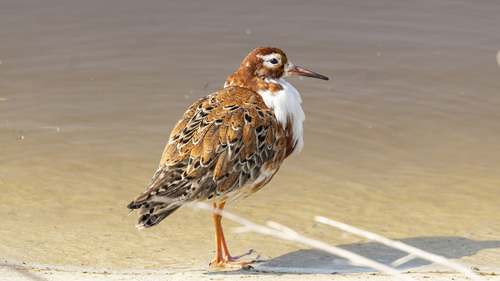
Ruff
The Ruff (Calidris pugnax) is a medium-sized sandpiper known for its remarkable breeding behavior, particularly the elaborate displays of males. It plays a crucial role in wetland ecosystems, primarily as a consumer of invertebrates. The species exhibits significant sexual dimorphism, with males being considerably larger and more colorful than females during the breeding season. Historically, the Ruff was hunted for food, and while that practice has diminished, it still faces considerable threats. It holds no widespread, specific cultural significance, other than representing a fascinating example of sexual selection in birds.
20-32 cm
Length
46-58 cm
Wingspan
Least Concern
Conservation Status
Distribution
Breeds across northern Eurasia, from Western Europe to eastern Siberia. Migrates to sub-Saharan Africa, southern Asia, and occasionally Australia. Altitudinal range varies from sea level to mountainous regions during migration.
Lifespan
Average lifespan in the wild is around 4-6 years, with some individuals living up to 10 years.
Ruff's Habitat
Habitat Types
Tundra, Wet grasslands, Marshes, Coastal mudflats, Floodplains
Climate Zones
Arctic, Subarctic, Temperate, Tropical
Adaptations
Long legs and bill are adapted for wading and probing in soft substrates. They possess slightly webbed feet, aiding in movement across muddy terrain.
Variations
No formally recognized subspecies, but there are variations in plumage and size across the breeding range.
Appearance
Breeding Plumage
Males develop elaborate ruffs and head tufts in breeding plumage, with colors ranging from black, chestnut, to white. Females and non-breeding males have cryptic brown and grey plumage.
Seasonal Feather Changes
Significant seasonal changes in males; females show less dramatic changes.
Sex Based Plumage Differences
Highly pronounced during breeding season; males are larger and have elaborate plumage, while females remain smaller and cryptically colored.
Notable Features
Males' prominent ruff and ear tufts during breeding season, Long, slightly decurved bill, Variable plumage coloration in breeding males
Diet and Feeding
Primary Foods
Insects, Crustaceans, Mollusks, Seeds, Worms
Foraging Behavior
Probes in mud and shallow water, often wading belly-deep. Also pecks at the surface and sometimes forages on drier ground.
Specializations
Their bill is sensitive to touch, allowing them to detect prey buried in the substrate.
Seasonal Diet Variations
Diet shifts with prey availability; more insects during breeding season, more seeds and other plant matter during migration and winter.
Behavior
Social Structure
Forms large flocks during migration and winter. Breeding males are territorial on leks, while females are not territorial.
Communication
Mostly silent outside of breeding season., Males make soft calls and hisses during courtship displays., Females have alarm calls to warn chicks of danger.
Migration
Long-distance migrant, traveling thousands of kilometers between breeding and wintering grounds. They often fly in large, mixed-species flocks.
Territorial or Group Behaviors
Independent males defend small territories on the lek. Satellite males use a different mating strategy, associating with independents. Faeder males mimic females to gain access to mating opportunities.
Conservation
Threats
Habitat loss and degradation (both breeding and wintering grounds), Climate change (affecting breeding success and habitat), Pollution (pesticides and heavy metals), Hunting (in some regions, although less prevalent now)
Protection Programs
International agreements like the African-Eurasian Waterbird Agreement (AEWA), Habitat restoration and protection projects in key areas
Local National Laws
Protected under various national laws in many countries across its range.
Population Trend
Decreasing
Population Estimates
Global population estimated to be around 2,000,000 individuals, but with significant declines in recent decades.
Interesting Facts
The Ruff has one of the most complex mating systems in the bird world.
The three distinct male morphs (independents, satellites, and faeders) have different plumage, behavior, and genetically determined mating strategies.
The name "Ruff" refers to the elaborate collar of feathers that males develop during breeding season.
This ruff is highly variable in color and pattern.
Females are called "Reeves."
This distinct name highlights the strong sexual dimorphism in the species.
Ruffs can migrate non-stop for thousands of kilometers.
They build up large fat reserves before undertaking these long journeys.
The faeder male is a rare example of a genetic polymorphism.
Their female-mimicking strategy is controlled by a 'supergene,' a cluster of linked genes.
Faqs about Ruff
Why are male Ruffs so different from females?
This is due to sexual selection, where females choose males based on their appearance and display, leading to the evolution of elaborate traits in males.
Where can I see a Ruff?
During migration, they can be found in wetlands, coastal areas, and flooded fields across Europe, Asia, Africa, and occasionally in Australia. Look for them in spring and autumn.
Are Ruffs endangered?
They are currently classified as Least Concern by the IUCN, but their population is declining due to various threats.
What is a lek?
A lek is a traditional display area where male birds gather to perform courtship displays for females.
Do both male and female Ruffs care for the chicks?
No, only the female Ruff (Reeve) incubates the eggs and raises the chicks. The male provides no parental care.
Copyright @ Nature Style Limited. All Rights Reserved.
 English
English